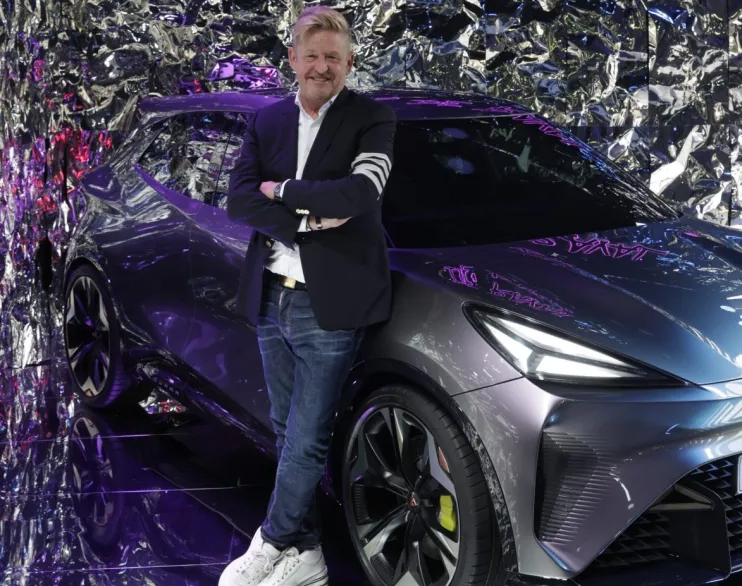Seat and Cupra chief: There’s a ‘perfect storm’ ahead for European carmakers

It’s only half a decade since Wayne Griffiths helped launch Europe’s blistering new sports car brand Cupra, convincing top executives at Volkswagen to back what many would have deemed too risky a venture.
The move would see Manchester-born Griffiths eventually take the helm of two Volkswagen-owned European marque’s, after his appointment as Seat chief in 2020.
It’s an impressive journey from his more modest beginnings selling cars in his dad’s showroom, but the idea for Cupra had played on Griffiths mind since his early days at Seat.
He recalls driving a 300 horsepower orange-wheeled Seat Leon Cupra on his first day, but was appalled at the design.
“The mirrors were orange, the wheels were orange and I’m saying why are these wheels orange? And the mirrors? They said because that’s cool. That’s not cool, paint it black and then it can be cool,” Griffiths told City A.M. in an interview.
That began the idea of spinning out Cupra as its own, high performance brand. Described as an unconventional challenger brand, the Seat spin-off, launched in 2018, would focus on more up-market, high performance sports cars with edgier designs.
And its strategy seems to have paid off, defying all expectations to become one of the fastest growing brands in Europe and a key profit driver for its parent company. This is a huge achievement given the continent is home to world-renowned brands like Mercedes-Benz and Porsche – both with decades of heritage behind them.
Where has the success come from?
“We’ve been able to hit a nerve out there with the young generation of car lovers, with our [sporty] design, our positioning, we’re authentic, we’re coherent,” Griffiths told City A.M.
Cupra has delivered close to half a million vehicles to customers since it first launched, with the lion share in the last six months amid an easing of the global semiconductor shortage.
“This year already we’re at 170, 000, which is almost 60 per cent up from last year and we’re going to end up doing about 250,000,” he said.
But for all the upbeat talk of recent success, the Mancunian strikes a cautious tone for the future of the wider industry.
A ‘perfect storm’
“There’s a perfect storm coming,” Griffith warns. Astronomic interest rates and inflation across Europe are pushing homeowners away from buying new cars.
“The whole cost side and economic environment is really, really complicated, probably the most complicated in the last 20 years,” he explained.
Cupra, alongside the rest of the industry, is racing to transition to electric fleets ahead of looming 2035 bans on the sale of petrol and diesel vehicles in the UK and Europe.
But automakers are facing an existential threat from an influx of ferocious Chinese manufacturers, whose cheaper EV models are putting traditional high-flyers to the test.
“The Chinese are not coming, they’re here.”
Wayne Griffiths, Seat and Cupra chief executive
“The Chinese are not coming, they’re here,” Griffiths said. “The best selling car to give you an anecdote, the best selling car in August in Spain was a Chinese car.”
Biden’s Inflation Reduction Act, which offers generous green incentives for US-based manufacturers, poses further problems, he added.
Tesla sold 138,814 of its Model Y in the first half of this year, almost double the volume sold over the same period in 2022.
“The competition game has changed,” Griffith said. “We have to get our act together not just as a company and as a group but also Europe…. Europe as a whole needs to pull together now [to] give an answer to this.”
UK and European automakers remain divided on banning sales of fossil fuel-guzzling vehicles. Rapidly phasing out petrol and diesel would force the sector to keep pace in the global EV race, but it could pave the way for the likes of China’s BYD to dominate the market.
Griffiths thinks arbitrary deadlines are not the answer. A more “pragmatic” approach would be incentivising electric car adoption and improving the continent’s lagging charging infrastructure.
“To be able to get to zero emissions means that you have to have an incredible amount of electric cars already on the street available, the product needs to be there at an affordable price,” he said.
Both Britain and Europe have rowed back on elements of their bans. Rishi Sunak pushed back the UK date from 2030 to 2035 in September, while Europe has allowed an exemption for combustion engine vehicles using e-fuels.
“Both in the UK and in Europe, they’re adapting their policy in line with the reality of consumers. You can’t force people and I think just by prohibition is not the way,” Griffith said.
“I don’t think anybody’s doubting the direction of where we need to go. It’s just the path to get there and we need to find a path that makes sense and is pragmatic.”
Closer to home
Since departing the UK in 1989 to work in Germany, Griffiths has spent over three decades learning the ins and outs of the European market
But he is keen to highlight that the UK remains a “key market” for Cupra, where sales jumped 42 per cent last year.
He explained that if you can crack the UK market, then success in others will follow.
“The UK is the home of… the best brands in the world in the car industry, from Jaguar to everybody. So if you want to be a cool brand, then you are going to have to be good in the UK.”